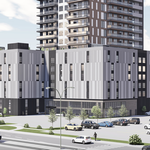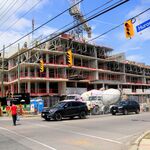Have a look at Google Streetview along St Clair. When they did the imagery, the eastern part (Vaughan to Yonge) was complete. West of Vaughan was in various stages of completion. Can you identify where they've had to move sewers (or where they are in process of moving sewers)?
If the original road was crowned, putting in a raised center median doesn't negate that crown (and would presumably further complement it).
But if the median is impermeable, you have to drain that as well. Ergo, you need to make some sort of modification to the storm sewers in order to drain it. In order for no work to have been done on the storm sewers, they would have had to have had the storm sewer running down the middle of the road, and would have had to put the drainage intake in the middle of the streetcar ROW, having the ROW drain inwards (towards the middle). I believe the storm sewers on St. Clair were on the sides, whether they were running to a single pipe running directly under the centre of the roadway I don't know, but logic would suggest they had to do modifications of some type in order to accomodate the new ROW.
This I'm somewhat skeptical of. How much are they budgeting for the surface LRT per km? How much per km would your BRT cost? (I'm thinking also of how much the York bus byway cost and it didn't include any trenching under existing major cross-streets as well as the cost of the Dufferin jog elimination which is a similar concept to your proposed trenching under half a dozen or more cross-streets.)
Well Sheppard East is averaging about $70 million/km. You can usually build a 2-lane roadway for about $15 million/km, but it can go up to $20, depending on standards. I don't have an exact number on the cost of overpasses.
Even if the west extension was done as LRT, it would at worst be cost-neutral with the current proposal (cost of reconstructing an entire roadway > cost of building new ROW with overpasses).
Is this accurate? With the capacity of the TC LRVs (running in two car trains as stated on the display panels at
http://www.toronto.ca/involved/proj...n_lrt/pdf/2009-11-20_display_panels_part1.pdf), how many buses would you need to provide the same capacity? How many additional operators would you have to hire (since I'm assuming you will need more than one bus to replace a two car train)?
I know you don't agree with the numbers, but panel 7 in the above link does show that the LRT capacity of Eglinton will be significantly greater than BRT.
The operational costs would be higher, yes. But remember, multiple routes can use the BRT service, in a lot of cases negating a transfer. Those are buses that would have been on the road anyway. From personal observation, only about 60% of the buses that use the Transitway through downtown Ottawa are 'Transitway' routes. The rest are local routes using the Transitway ROW.
And as I pointed out earlier, in the 1st Ottawa LRT plan, the increase in capacity from going from BRT to surface LRT was only a couple thousand pphpd. It was seen by many as being a 'band-aid' solution. Run properly, BRT can carry very close to what surface LRT (non-grade separated) can carry.
Ok, I agree that those concerns of the residents shouldn't count for a huge negative against the project. I wouldn't think though that half a dozen or more sharp downs and ups through the trenched underpasses would be as appealing to riders as a smoother LRT trip.
Agreed. LRT is a smoother ride, much less lateral movement. I'm merely looking at cost/benefit here.




